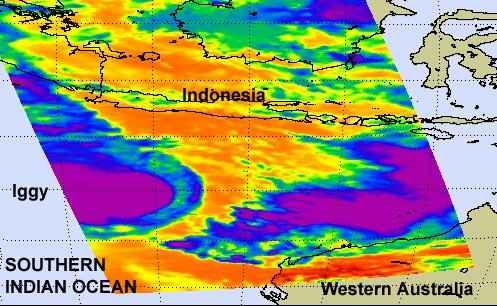
An area of developing low pressure, which eventually developed into Tropical Cyclone Iggy, triggered tornadoes across the islands of Java and Bali in Indonesia. The tornadoes damaged nearly 1,000 houses, with almost 500 homes damaged in the Seribu Islands alone. Seven people were killed by these tornadoes, with nearly 51 people injured. Three people were killed by falling trees in Purbalingga, two in Bali, one in South Jakarta, and one in Wonosobo. Tornadoes from tropical cyclones are not uncommon.
The area of low pressure that was developing across the eastern Indian ocean formed into Tropical Cyclone Iggy, which now has sustained winds of 55 miles per hour. The forecast for Cyclone Iggy is for it to move to the southeast near Exmouth in Western Australia. The projected path is unclear if Iggy will make landfall, but it will be very close. Most of the models show Iggy scraping the Australian coasts, which is enough to bring heavy rains, storm surge, and strong winds across the area. Once it nears Exmouth, it will move to the southwest and move around Western Australia. During this time, the storm is likely to become stronger and could strengthen into a Category 2 hurricane with wind speeds over 95 mph.

Tropical systems, such as Iggy, can and have the history of producing tornadoes. The strongest part of a tropical cyclone is on the southeast quadrant of the storm (for cyclones spinning in the southern Hemisphere). In the southeast quadrant, the strongest winds, thunderstorms, and tornadoes can be formed. Water temperatures ahead of Iggy are very warm, so conditions are very favorable for further development. The stronger the storm becomes, the threats for damage moves upward. Areas across Western Australia will have to monitor the situation closely. The biggest initial concern is the heavy rains that could cause flooding problems and leave roads closed and stranding visitors of the region.
Bottom line: An area of low pressure developed across the eastern Indian Ocean and sparked tornadoes across parts of Indonesia. Seven people were killed with nearly 51 people injured. Over a thousand homes were damaged in the islands of Java and Bali. The area of low pressure pushed to the southeast and became Tropical Cyclone Iggy. Iggy is currently a tropical storm with 55 mph and is forecast to develop into a strong Category 2 Cyclone (hurricane) with winds over 95 mph. Flooding and few isolated tornadoes are possible across Western Australia as the southeast quadrant of the storm grazes by the area. The forecast for Iggy is for the storm to scrape the beaches of Western Australia near Exmouth and Australia’s Coral Coast.











